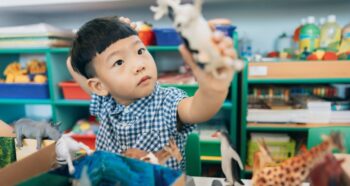Food. It’s an essential part of our survival and many of us assume that we’re born with a liking for a wide range of foods when, in reality, food preferences vary considerably between individuals. Once we are weaned onto solid foods, it can take time for us to learn to like different foods. Caregivers and education settings (nurseries/kindergartens, preschools, and schools) all have an important role in helping children to learn to like food. The eating habits we develop in childhood stay with us throughout adolescence and adulthood, so this is a key time to support children’s developing relationships with food. The more we understand about food and nutrition, the more we can also learn to eat healthily as adults.
This blog, written by our Head of Teaching and Learning Strategy, Paul Ellis, and Emma Haycraft, Professor of Psychology and Public Health, at Loughborough University, UK, focuses on educating young children and caregivers to eat healthily. Our Head of Teaching and Learning Strategy has also worked on a series of podcasts with academic experts focusing on nutrition. This blog is written to accompany the first episode of the podcasts: How to Educate Young Children and Caregivers about Healthy Eating where he discusses the topic with Professor Emma Haycraft.
One key factor in learning to like food is that we need to be ‘exposed’ to it, often several times. This notion of ‘repeated exposure’ is key to us becoming more familiar with, and less wary about, a food. Research shows that it can take 7-15 exposures to a food before we start to like it. Eating a food in front of a child (role modelling) and offering the child a non-food reward (for example, a sticker) for trying a new food can both help children to become more familiar with that food which, in turn, can increase liking and intake. Research also tells us that children love to learn about food and to be more involved with it; be that growing it, singing songs about it, or simply choosing and preparing it.
Fussy eating, or food refusal, is often partly linked to children feeling wary about unfamiliar foods, or foods which look unusual, or even foods just being served in a way that the children are not used to. Helping children to learn about foods, making food fun, and increasing children’s engagement with food, in all its forms, can really help children to overcome these food fears and reduce their fussy eating behaviour.
There are lots of ways that we can help to make food fun and caregivers and education settings can have an important role in supporting this. For example:
Play
- Find pictures of fruit and vegetables that children can colour or cut out and stick.
- Use Play-Doh (a soft substance used by children for making models) to make fruit and vegetables.
- Encourage children to engage in role-play games, such as “at the shops” or “at a cafe” to try new foods in a relaxed way.
Grow
- Grow your own! You don’t need expensive equipment or even a garden. Many foods can be grown indoors, for example in yoghurt pots or on a windowsill. Children will enjoy learning about how foods are grown and tasting the results.
Learn
- Teaching children about foods by reading or learning about them is an effective way to help children to become more familiar with foods.
- Reading books that have images of foods in them, or that have a food-related theme, and talking about this afterwards is a great way to expose children to foods away from mealtime.
- There are many computer games and apps that teach children about (healthy) eating and introduce them to the idea of nutrients. This can be a fun way to learn.
- Introduce a learning challenge with children in your care. For pre-schoolers, this could involve learning about foods that are the same colour (for example, clementines, carrots, butternut squash and sweet potatoes are all orange in colour). For older children, this could be learning about different types of food or food groups (for example, citrus fruit) and what makes them healthy to eat. You could choose a new food each week.
Implementing some of these suggestions into day-to-day activities, alongside offering children a variety of different foods and role-modelling eating them, are all effective strategies to help children to learn to like food.
Want more tips and suggestions?
If you are interested to learn more about eating healthily – throughout the whole life span – we have just released a mini-series of five podcasts on the topic, in collaboration with academics from Loughborough University in the UK.
You can find all the episodes, including the one in which Professor Haycraft, is a guest, on the Brighter Thinking Pod website.
For ways to support children’s developing eating behaviours, read more on the Child Feeding Guide website.
And finally, you can learn more about Loughborough’s research into health and wellbeing on their dedicated webpages.





